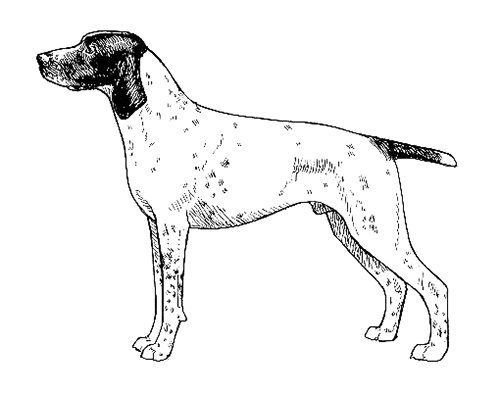Braque d'Auvergne
Gun Dog Group
The goals and purposes of this breed standard include: to furnish guidelines for breeders who wish to maintain the quality of their breed and to improve it; to advance this breed to a state of similarity throughout the world; and to act as a guide for judges.
Breeders and judges have the responsibility to avoid any conditions or exaggerations that are detrimental to the health, welfare, essence and soundness of this breed, and must take the responsibility to see that these are not perpetuated.
Any departure from the following should be considered a fault, and the seriousness with which the fault should be regarded should be in exact proportion to its degree and its effect upon the health and welfare of the dog and on the dog’s ability to perform its traditional work.
History
The Braque d’ Auvergne, or “Auvergne Pointer”, was developed in France by hunters who wanted a strong dog that could hunt tirelessly. It is a breed of ancient origins, known for two centuries in the Cantal region.
The Braque d’ Auvergne was recognized by the United Kennel Club in 2006.
General Appearance
A sturdy, robust, short-coated, black and white pointing dog of medium size, with distinctive Braque characteristics, his appearance suggests the capacity to work all day, covering a great deal of ground with supple action.
Characteristics
Kind, intelligent and tractable, the Braque d’ Auvergne has natural hunting instincts and a keen sense of smell. He is also well suited to family life.
Head
The head is long, in proportion to the size of the dog, and characteristically somewhat lighter in females than in males. The stop is moderate but defined. In profile, the lines of the skull and the muzzle are slightly divergent.
SKULL
Viewed from above, the skull is oval in shape. The occiput is only moderately defined. The width of the skull between the zygomatic arches is equal to its length.
MUZZLE
Same length as the skull, with a straight nasal bone. Upper lips overlap the lower, forming a square end to the muzzle.
Serious Faults: Parallel head planes, concave or convex muzzle, pointed muzzle. Over-developed lips.
TEETH
A full complement of strong teeth meet in a scissors or level bite.
EYES
Fairly large and set rather deeply, oval in shape and dark hazel in color, which creates a kind expression. Third eyelid is fully pigmented, as are eye rims. Whites of eyes are not apparent.
NOSE
Large and broad with well opened nostrils. Black and shiny. Set on as an extension of the muzzle, slightly protruding.
EARS
Set low and well back on skull. Rounded at the tip, with a slight inward fold. Leather should reach to the nose but not beyond.
Serious Faults: High set, short or corkscrew ears.
Neck
Long and slightly arched, approximately the same length as the head. Slight dewlap.
Forequarters
Shoulders strong and well muscled, with the shoulder blade sloping at a 45-degree angle to permit free movement.
FORELEGS
Long, muscular and straight with elbows held close to the body. Distance from elbow to ground equals distance from top of withers to elbow. Pastern is short and slightly sloping.
Body
Square in proportion, measured from breastbone to buttocks and withers to ground. Chest deep rather than wide, with oval shaped ribs. Withers high, back short, straight and not wide. Loin short and wide, especially in females. Croup slopes gently to set on of tail. Flanks are wide and only slightly hollowed with moderate tuck-up.
Hindquarters
Well angulated to match forequarters.
HIND LEGS
Strongly muscled. Hock joint lean and well defined. Rear pastern short and strong.
Feet
Oval in shape with deep, hard pads and tightly knit toes. Both front and rear feet point straight ahead.
Tail
Strong at the base, set on rather high and carried horizontally. If docked, it should be 6 to 8 inches in length. If natural, it should reach to the hock joint but not further.
Coat & Skin
Coat is short and shiny, not too fine. Skin is fine and rather loose but without exaggeration.
Color
Black with white markings, either ticked or roaned. Head preferably black, with a white blaze, but white with ticking or roaning is acceptable.
Height
Males 22½ to 24½ inches at the withers
females 21 to 23 inches.
Gait
An endurance trot, long-strided, but without exaggeration.
Eliminating Faults
(An Eliminating Fault is a Fault serious enough that it eliminates the dog from obtaining any awards in a conformation event.)
Teeth: overshot or undershot, missing any teeth other than the first premolars.
Eyes: entropian, ectropian, light yellow (hawk) eyes, wall eyes, unpigmented eyerims.
Nose: Dudley nose.
Color: Solid black or solid white. Absence of ticking or roaning (clear white markings). Tawny or fawn shading or markings in coat.
Height: more than one inch over or under stated size.
Disqualifications
(A dog with a Disqualification must not be considered for placement in a conformation event, and must be reported to UKC.)
Unilateral or bilateral cryptorchid.
Viciousness or extreme shyness.
Albinism.
The docking of tails and cropping of ears in America is legal and remains a personal choice. However, as an international registry, the United Kennel Club is aware that the practices of cropping and docking have been forbidden in some countries. In light of these developments, the United Kennel Club feels that no dog in any UKC event, including conformation, shall be penalized for a full tail or natural ears.

Looking for a Dog?
Find a dog that will fit your family.
Note: The breeders on this list are not endorsed by UKC.
©Copyright 2006, United Kennel Club
